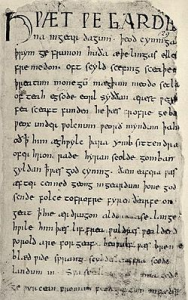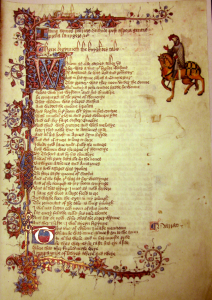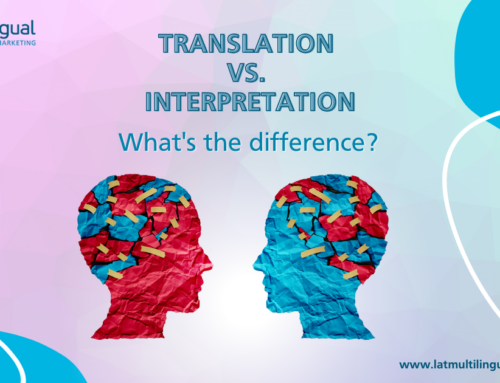“Whanne that April with his shoures sote
The droughte of March hath perced to the rote.”
…Right. If you’re not up on your Middle English the opening lines of Geoffrey Chaucer’s The Canterbury Tales might leave you wanting a modern-day English translation, but the language is far from unrecognizable. What if we jump ahead a few centuries to see where it takes us…
“Shall I compare thee to a summer’s day?
Thou art more lovely and more temperate:
Rough winds do shake the darling buds of May,
And summer’s lease hath all too short a date:”
…Getting better. The famous beginning to Shakespeare’s “Sonnet 18” may be more clear than Chaucer’s Middle English, but still not quite like the language we all know and love today. A lot has changed since Shakespeare, and even more so since Chaucer, but its origins go much further back.
Old English

Middle English

Early Modern English

Modern English
Between Early Modern English and Modern English, the changes are seen in the vocabulary. The Industrial Revolution brought about the need for language and descriptions that weren’t necessary before. As the British Empire set about colonizing the world, English picked up words from all the different languages it acquired. Today, the English language adapts to many regions, such as: Britain, America, Australia and India. Effective communication requires localization for each different region it reaches.
The Future…
Just because we’ve reached the Modern day, doesn’t mean we stop here! Just like the Industrial Revolution had a huge influence on bringing about change, todays language continues to be influenced by technological advances. This time it is digital technology bringing about this change. Since the birth of computers and the internet, digital communication has changed the way we use and think about language. Besides the creation of actual vocabulary surrounding technology, the methods of communication are changing as well. The two biggest ways in which we see these changes are in cell phones and social media, and now with the popularity of the smartphone I am going to combine these two factors and focus solely on social media.

It’s not just English undergoing these changes either, because anything digital has the potential to be on a global platform, all languages must be adapting to the new changes that are arising. As more and more people and businesses are turning to social media, it is becoming essential to expand your digitized messages beyond one single language. Multilingual social media is the ultimate way to connect with a global audience.
So it would appear that English has come a long way these past centuries, and it is continuing to change and evolve today. The digital world is fundamentally altering the way we communicate, and could it be that we are reaching the point where English is evolving to a point beyond itself? It is no longer feasible for one language to dominate, as social media increases global interconnectivity it would appear that any message that wants spreading needs to be multilingual. Shakespeare wrote “All the world’s a stage” and social media is making this truer than ever. This means that it is no longer enough to have something in the most modern up-to-date English. You now need the multilingual translations as well if your message wants to be understood on a global platform.
Get Involved
Even if you are only communicating in one language, doing this effectively requires proper localization. Translation companies, such as LAT, make it easy to access experienced translators living in your target markets. If you are ready to get involved in multilingual communication, we can help take you to the next level. We have the experience necessary to spread your message in a way that will be understood.












